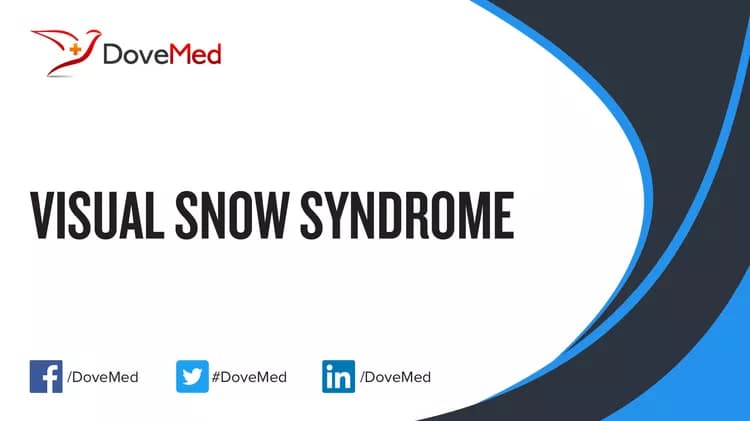What are the other Names for this Condition? (Also known as/Synonyms)
- Snowy Vision
- VS (Visual Snow Syndrome)
What is Visual Snow Syndrome? (Definition/Background Information)
- Visual Snow Syndrome (VS) is described as a persistent visual problem characterized by seeing snow-like dots. Migraines are a common symptom
- Many people also see drifting blobs of varying size and shape (floaters), visual effects (entopic phenomenon), glare, halos, starbursts, trails, odd colors and shapes, and may have persistent recurrence of a visual image (palinopsia) and double vision. Additional symptoms may include fatigue, tinnitus, or depersonalization and depression
- Most people have normal vision tests and normal brain images. Standard migraine treatments are often not helpful
- There is no cure or effective treatment to completely relieve the symptoms, but medication seems to help some people with Visual Snow Syndrome
(Source: Visual Snow Syndrome; Genetic and Rare Disease Information Center (GARD) of National Center for Advancing Translational Science (NCATS), USA.)
Who gets Visual Snow Syndrome? (Age and Sex Distribution)
- Visual Snow Syndrome is a rare congenital disorder. The exact prevalence of this condition is not known
- The presentation of symptoms may occur at any age
- Both males and females may be affected
- Worldwide, individuals of all racial and ethnic groups may be affected
What are the Risk Factors for Visual Snow Syndrome? (Predisposing Factors)
- Currently, no risk factors have been clearly identified for Visual Snow Syndrome
It is important to note that having a risk factor does not mean that one will get the condition. A risk factor increases one’s chances of getting a condition compared to an individual without the risk factors. Some risk factors are more important than others.
Also, not having a risk factor does not mean that an individual will not get the condition. It is always important to discuss the effect of risk factors with your healthcare provider.
What are the Causes of Visual Snow Syndrome? (Etiology)
The exact cause of development of Visual Snow Syndrome is not known at the present time.
What are the Signs and Symptoms of Visual Snow Syndrome?
The signs and symptoms of Visual Snow Syndrome may include the following: (in the field of vision)
- Snow-like dots
- Blobs of varying size and shape (floaters)
- Visual effects (entopic phenomenon)
- Glare
- Halos
- Starbursts
- Trails
- Odd colors and shapes
- Persistent recurrence of a visual image (palinopsia)
- Double vision
Additional signs and symptoms may include:
- Fatigue
- Tinnitus
- Depersonalization
- Depression
- Migraine headaches
How is Visual Snow Syndrome Diagnosed?
The diagnosis of Visula Snow Syndrome is made on the basis of the following tools:
- Complete physical examination and eye examination
- Thorough medical history evaluation
- Assessment of signs and symptoms, with criteria for inclusion and exclusion: Dynamic dots in the entire visual field, with at least one of the following additional symptom
- Visual trailing
- Floaters
- Photophobia
- Tinnitus
- Impaired night vision
The above symptoms should not be part of aura associated with migraine. And, the symptoms should not be part of a separate disorder.
- Laboratory tests
- Imaging studies of the eye
Many clinical conditions may have similar signs and symptoms. Your healthcare provider may perform additional tests to rule out other clinical conditions to arrive at a definitive diagnosis.
What are the possible Complications of Visual Snow Syndrome?
The complications of Visual Snow Syndrome may include:
- Inability to see objects clearly
- Presence of dots in the visual field to such an extent that it affects normal day-to-day activities
Complications may occur with or without treatment, and in some cases, due to treatment also.
How is Visual Snow Syndrome Treated?
Presently, there is no cure for Visual Snow Syndrome. The treatment is usually given to manage the signs and symptoms and any complication that develops.
How can Visual Snow Syndrome be Prevented?
The cause of Visual Snow Syndrome is not knownn at the present time, and therefore, no guidelines or methods are available for its prevention.
What is the Prognosis of Visual Snow Syndrome? (Outcomes/Resolutions)
- The prognosis of Visual Snow Syndrome is dependent upon the severity of the signs and symptoms and associated complications, if any
- Individuals with mild conditions have better prognosis than those with severe symptoms and complications
- Typically, the prognosis may be assessed on a case-by-case basis
Additional and Relevant Useful Information for Visual Snow Syndrome:
The following DoveMed website link is a useful resource for additional information:
Related Articles
Test Your Knowledge
Asked by users
Related Centers
Related Specialties
Related Physicians
Related Procedures
Related Resources
Join DoveHubs
and connect with fellow professionals


0 Comments
Please log in to post a comment.